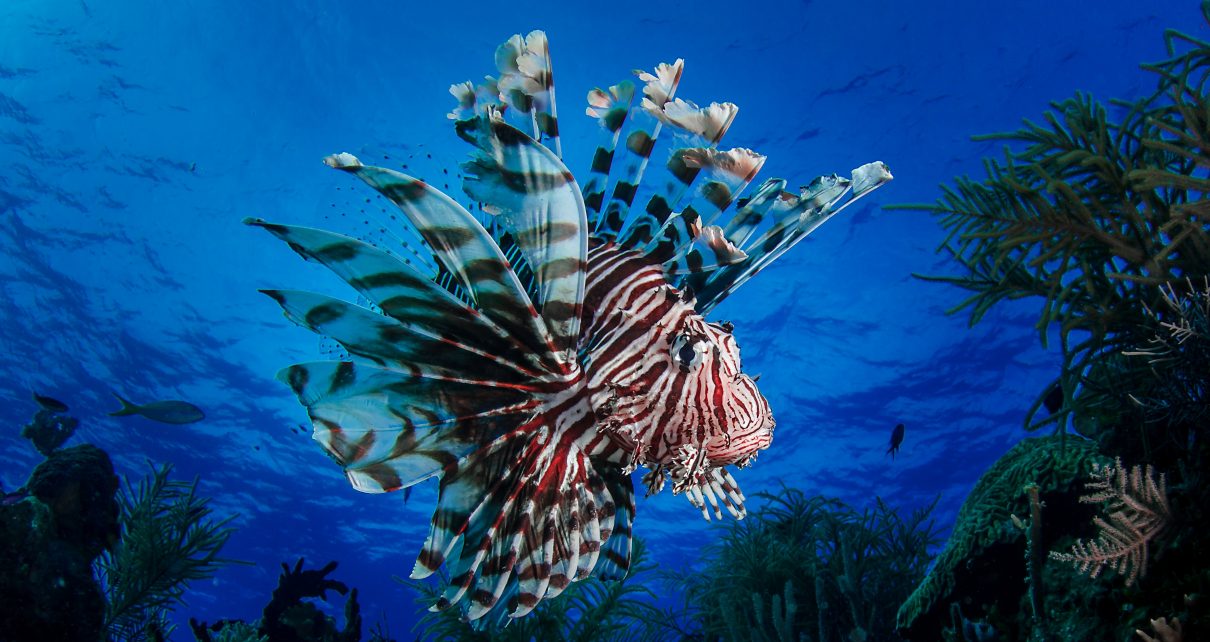Native to the Indian and Pacific oceans, lionfish invaded coral reefs in the Bahamas beginning in the early 2000s—likely when multiple aquarium owners surreptitiously liberated some of these fast-growing tank menaces into the Atlantic. As new predators with no enemies and venomous spines, lionfish have multiplied almost unimpeded and have wreaked havoc on Bahamian coral reef fish species, especially little ones. Invasive predators often capitalize on the naivete of native species that do not recognize them as a threat—at least initially. But heavy predation is presumed, over time, to place intense selection pressure on prey to develop a fear of the new species.
In 2015, a decade after the lionfish invasion took hold in her study area, coral reef ecologist Isabelle Côté was curious: Are native Caribbean fish becoming wary of these dangerous newcomers? She and her graduate student Adrienne Berchtold, both then at Simon Fraser University in British Columbia, conducted a series of experiments at the Cape Eleuthera Institute in the Bahamas to find out. They published their results on Tuesday in Animal Behaviour.
First, the researchers donned scuba gear and collected baby striped parrotfish, which lionfish commonly eat. The scientists took some of these specimens from two reefs known to have many predators (including lionfish) and others from two reefs with few of them. Côté and Berchtold placed the parrotfish in tanks with a sandy bottom and hiding places made of PVC pipe. Then they watched the parrotfish’s behavior before and after lifting a barrier to an adjacent tank so the animals could see one of three things: a lionfish, a grouper (a scary-looking native predator that eats parrotfish) or a control environment containing only seawater.
Fish can also smell predators. So the scientists further tested the parrotfish’s response by injecting lionfish and grouper effluent—an excretory soup from the predators’ water—into their tanks. (For a control condition, the researchers used a squirt of plain seawater.) Additional trials simultaneously combined the visual and olfactory cues.
After all of these evasion tests, the same parrotfish fish were subjected to studies of survival. If specific fish in the evasion trials had been deemed relatively naive because they exhibited less fearful behavior, it was predicted they would be more likely to get eaten. The parrotfish were placed in tanks containing a hungry lionfish, as well as conch shells for shelter. The researchers then recorded the ensuing drama for up to two hours.
What happened? In the evasion trials, when most of the parrotfish saw or smelled a grouper, they swam less, frequently froze and cowered away. But their reaction to a lionfish did not significantly vary from their response to the plain-seawater control.
In the survival trials, 57 percent of the parrotfish tested were eaten. And the best predictor of a fish’s survival was how long it had hidden during the evasion trials. The length of this period was interpreted as a measure of “shyness” or “boldness.”
Bold fish were more likely to come from the low-predation reefs—and to be gobbled up. Shy fish mainly came from high-predation reefs. They had a significantly higher chance of surviving—not because they recognized lionfish as predators, but because they were simply more afraid in general. “To me, that’s the coolest part,” Côté says. These scaredy-fish were neophobic, even fearing empty neighboring tanks and squirts of plain seawater.
Fear ecologist Liana Zanette of Western University in Ontario, who was not involved with the study, calls it “extremely thorough, thoughtful, and well designed.” She suggests the research indicates that striped parrotfish do not recognize lionfish as predators, despite 10 years of cohabiting with them.
So how long does it take for native prey to develop recognition of a new predator on the block? It depends. Previous studies involving other species reveal huge variations, from a few years to centuries. Some species have been wiped out because they never adapted to invasive predators at all.
One big implication of the new paper, says University of Washington predator biologist Aaron Wirsing, who was not involved in the study, is that “lionfish may be selecting for more cautious prey populations.”
“To be shy is usually a lousy lot in life,” Côté says, referring to other studies that found guarded fish get less to eat. With lionfish in the mix, however, shyness is a major survival advantage. Being generally scared of everything helps when encountering a new predator. Strong selection for shy fish may not bode well for the hunting success of native predators—but Côté speculates it may underpin declining lionfish numbers recently observed in the northern Caribbean.




